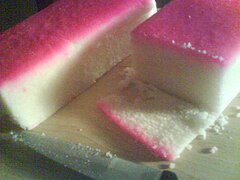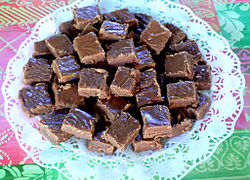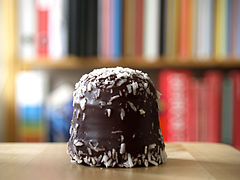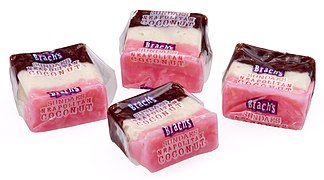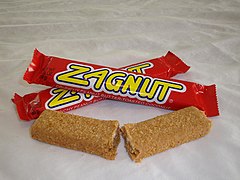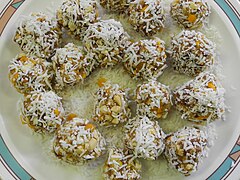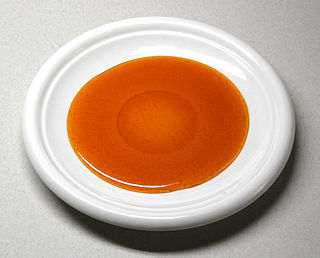
Caramel is an orange-brown confectionery product made by heating a range of sugars. It can be used as a flavoring in puddings and desserts, as a filling in bonbons or candy bars, or as a topping for ice cream and custard.

Glutinous rice is a type of rice grown mainly in Southeast and East Asia, and the northeastern regions of South Asia, which has opaque grains, very low amylose content, and is especially sticky when cooked. It is widely consumed across Asia.

The Heath bar is a candy bar made of toffee, almonds, and milk chocolate, first manufactured by the Heath Brothers Confectionery in 1928. Since its acquisition of the Leaf International North American confectionery operations late in 1996, the Heath bar has been manufactured and distributed by Hershey.
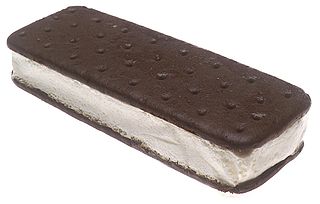
An ice cream sandwich is a frozen dessert consisting of ice cream between two biscuits, wafers, cookies, or baked goods. The ingredients are different around the world, with Ireland using wafers and the United States commonly using cookies.
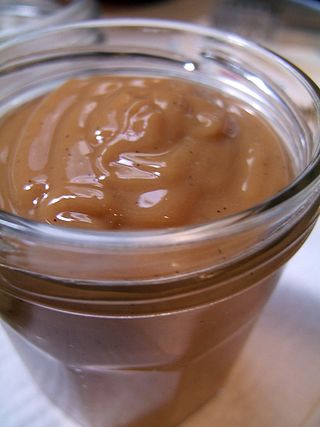
Dulce de leche, caramelized milk, milk candy or milk jam, is a confection popular in Latin America, also found in French and Polish (kajmak) cuisines, prepared by slowly heating sugar and milk over a period of several hours. The resulting substance, which takes on a spreadable, sauce-like consistency, derives its rich flavour and colour from non-enzymatic browning. It is typically used to top or fill other sweet foods.

Hershey's Kisses is a brand of chocolate first produced by the Hershey Company in 1907. The bite-sized pieces of chocolate have a distinctive conical shape, sometimes described as flat-bottomed teardrops. Hershey's Kisses chocolates are wrapped in squares of lightweight aluminum foil. A narrow strip of paper, called a plume, sticks out from the top of each Hershey's Kiss wrapper. Originally designed as a flag for the "Hershey's" brand, the printed paper plumes were added to the Kisses product wrapper in 1921 to distinguish the Hershey's Kiss from its competitors who were offering similar products.

Kuih are bite-sized snack or dessert foods commonly found in Southeast Asia and China. It is a fairly broad term which may include items that would be called cakes, cookies, dumplings, pudding, biscuits, or pastries in English and are usually made from rice or glutinous rice. In China, where the term originates from, kueh or koé (粿) in the Min Nan languages refers to snacks which are typically made from rice but can occasionally be made from other grains such as wheat. The term kuih is widely used in Malaysia, Brunei, and Singapore, kueh is used in Singapore and Indonesia, kue is used in Indonesia only, all three refer to sweet or savoury desserts.

Quality Street is a line of tinned and boxed toffees, chocolates and sweets, first manufactured by Mackintosh's in Halifax, West Yorkshire, England, in 1936. It was named after J. M. Barrie's play Quality Street. Since 1988 they have been produced by Nestlé. Quality Street have long been a competitor to Cadbury Roses which were launched by Cadbury in 1938.

Kue is an Indonesian bite-sized snack or dessert food. Kue is a fairly broad term in Indonesian to describe a wide variety of snacks including cakes, cookies, fritters, pies, scones, and patisserie. Kue are made from a variety of ingredients in various forms; some are steamed, fried or baked. Kue are popular snacks in Indonesia, which has the largest variety of kue. Because of the countries' historical colonial ties, Koeé (kue) is also popular in the Netherlands.

Suman or budbud is a rice cake originating in the Philippines. It is made from glutinous rice cooked in coconut milk, often wrapped in banana leaves, coconut leaves, or buli or buri palm (Corypha) leaves for steaming. It is usually eaten sprinkled with sugar or laden with latik. A widespread variant of suman uses cassava instead of glutinous rice.
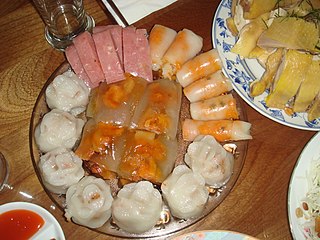
In Vietnamese, the term bánh translates loosely as "cake" or "bread", but refers to a wide variety of prepared foods that can easily be eaten by hands or chopsticks. With the addition of qualifying adjectives, bánh refers to a wide variety of sweet or savory, distinct cakes, buns, pastries, sandwiches, and other food items, which may be cooked by steaming, baking, frying, deep-frying, or boiling. Foods made from wheat flour or rice flour are generally called bánh, but the term may also refer to certain varieties of noodle and fish cake dishes, such as bánh canh and bánh hỏi.

A candy bar is a type of candy that is in the shape of a bar. The most common type of candy bar is the chocolate bar, including both bars made of solid chocolate and combination candy bars, which are candy bars that combine chocolate with other ingredients, such as nuts, caramel, nougat, or wafers.

Kẹo dừa is a Vietnamese coconut candy most commonly produced in Bến Tre province, Vietnam, with coconut milk and coconut cream. The Ben Tre Province is nicknamed by the Vietnamese as the "Land of Coconut". The Vietnamese term for coconut candy is "kẹo dừa", with kẹo = candy and dừa = coconut. Coconut candy was originally associated with Mo Cay, a township within the Bến Tre province.
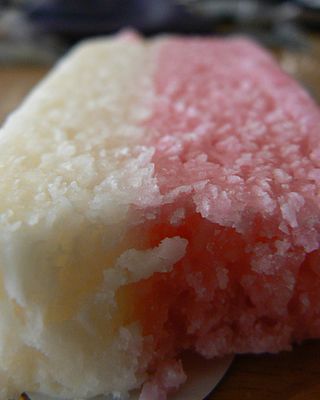
Coconut ice is a British confectionery prepared using grated desiccated coconut or just grated coconut, condensed milk and sugar, which is formed to create a solid, soft candy. It typically has a chewy, soft and mildly grainy texture; some versions are semi-hard. Coconut ice is also available in South Africa, some areas of Australia and New Zealand.


